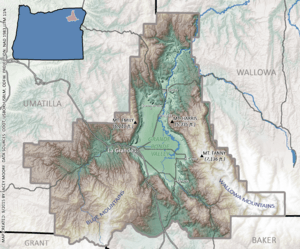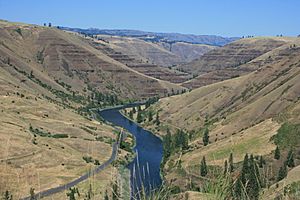Union County, Oregon facts for kids
Quick facts for kids
Union County
|
|
|---|---|
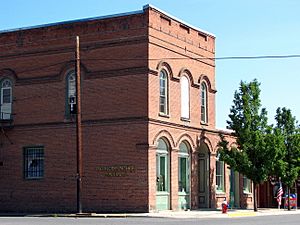
Union County Museum
|
|
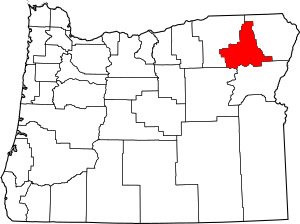
Location within the U.S. state of Oregon
|
|
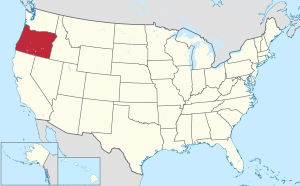 Oregon's location within the U.S. |
|
| Country | |
| State | |
| Founded | October 14, 1864 |
| Seat | La Grande |
| Largest city | La Grande |
| Area | |
| • Total | 2,039 sq mi (5,280 km2) |
| • Land | 2,037 sq mi (5,280 km2) |
| • Water | 1.9 sq mi (5 km2) 0.1%% |
| Population
(2020)
|
|
| • Total | 26,196 |
| • Estimate
(2021)
|
26,212 |
| • Density | 13/sq mi (5/km2) |
| Time zone | UTC−8 (Pacific) |
| • Summer (DST) | UTC−7 (PDT) |
| Congressional district | 2nd |
Union County is one of the 36 counties in the U.S. state of Oregon. As of the 2020 census, the population was 26,196. Its county seat is La Grande.
Union County comprises the La Grande, OR Micropolitan Statistical Area. It is one of the eight counties of eastern Oregon.
Contents
History
According to Oregon Geographic Names, the county is named for the town of Union. Union County was originally part of Wasco County. The northern end of the Grande Ronde Valley was the first part to be settled. During the 1860s, population growth in eastern Oregon prompted the State Legislature to split Umatilla and Baker Counties from Wasco County in 1862. Further settlement in the Grande Ronde Valley led to the division of Baker County to create Union County on October 14, 1864. The county doubled in population between 1880 and 1890.
The choice of a county seat resulted in competition, based on geography and on economic and population growth, between La Grande and the city of Union. The county seat alternated between Union and La Grande until it permanently came to rest at La Grande in 1905. Between 1875 and 1913, adjustments were made between Union County's borders and the borders of Baker, Umatilla, and Wallowa counties.
Geography
According to the U.S. Census Bureau, the county has a total area of 2,039 square miles (5,280 km2), of which 2,037 square miles (5,280 km2) is land and 1.9 square miles (4.9 km2) (0.1%) is water. The Forest Service owns 47% of the land in the county.
Adjacent counties
- Umatilla County (west)
- Wallowa County (east)
- Baker County (south)
- Grant County (southwest)
Demographics
| Historical population | |||
|---|---|---|---|
| Census | Pop. | %± | |
| 1870 | 2,552 | — | |
| 1880 | 6,550 | 156.7% | |
| 1890 | 12,044 | 83.9% | |
| 1900 | 16,070 | 33.4% | |
| 1910 | 16,191 | 0.8% | |
| 1920 | 16,636 | 2.7% | |
| 1930 | 17,492 | 5.1% | |
| 1940 | 17,399 | −0.5% | |
| 1950 | 17,962 | 3.2% | |
| 1960 | 18,180 | 1.2% | |
| 1970 | 19,377 | 6.6% | |
| 1980 | 23,921 | 23.5% | |
| 1990 | 23,598 | −1.4% | |
| 2000 | 24,530 | 3.9% | |
| 2010 | 25,748 | 5.0% | |
| 2020 | 26,196 | 1.7% | |
| 2021 (est.) | 26,212 | 1.8% | |
| U.S. Decennial Census 1790-1960 1900-1990 1990-2000 2010-2020 |
|||
2010 census
As of the 2010 census, there were 25,748 people, 10,501 households, and 6,804 families living in the county. The population density was 12.6 inhabitants per square mile (4.9/km2). There were 11,489 housing units at an average density of 5.6 per square mile (2.2/km2). The racial makeup of the county was 93.1% white, 1.1% American Indian, 0.9% Pacific islander, 0.8% Asian, 0.5% black or African American, 1.3% from other races, and 2.3% from two or more races. Those of Hispanic or Latino origin made up 3.9% of the population. In terms of ancestry, 25.2% were German, 17.8% were Irish, 17.3% were English, and 6.9% were American.
Of the 10,501 households, 28.2% had children under the age of 18 living with them, 51.3% were married couples living together, 9.5% had a female householder with no husband present, 35.2% were non-families, and 27.6% of all households were made up of individuals. The average household size was 2.38 and the average family size was 2.89. The median age was 40.0 years.
The median income for a household in the county was $42,162 and the median income for a family was $52,558. Males had a median income of $40,720 versus $30,373 for females. The per capita income for the county was $22,947. About 10.5% of families and 16.1% of the population were below the poverty line, including 22.6% of those under age 18 and 10.2% of those age 65 or over.
Communities
Cities
- Cove
- Elgin
- Imbler
- Island City
- La Grande (county seat)
- North Powder
- Summerville
- Union
Unincorporated communities
Economy
The initial economic interest in Union County was mining, but most of the mines were in the area annexed by Baker County in 1901. The local economy continues to be based on natural resources, including farming (wheat, fruit, vegetables, mint, and grass seed), ranching (cattle and sheep), and timber. The ridges of Pyles Canyon are the site of the Elkhorn Valley Wind Farm, owned and operated by Horizon Wind Energy and whose power is sold to Idaho Power. Since October 2010, the county board of commissioners has supported a "strategic investment program" for another wind power project in Oregon, Horizon Wind Energy's proposed Antelope Ridge Wind Farm; after delays due to concerns about the project's impact on wildlife, the project has received support from Oregon Department of Fish and Wildlife.
Nearby mountains and streams offer hunting, fishing, skiing, and camping, all of which attract vacationers. Attractions include the Anthony Lakes (and its ski area), Minam River, Mount Emily, Blue Mountains, Umatilla National Forest, Wallowa–Whitman National Forest (including Eagle Cap Wilderness), Catherine Creek State Park, Hilgard Junction State Recreation Area, Thief Valley Reservoir, Cove Hot Springs Pool, the Hot Lake Hotel (first built in the 1860s due to nearby hot springs), and the Eagle Cap Excursion Train.
See also
 In Spanish: Condado de Union (Oregón) para niños
In Spanish: Condado de Union (Oregón) para niños


